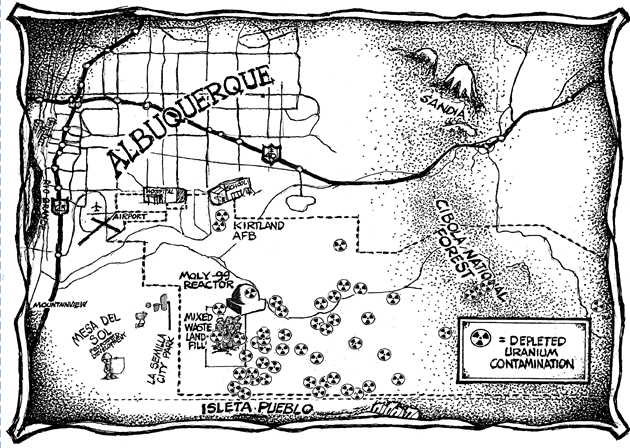
Concerned Citizens for Nuclear Safety (CCNS)
Concerned Citizens for Nuclear Safety (CCNS) is one of 39 environmental and peace organizations that won a landmark lawsuit against the U.S Department of Energy for failure to follow-through on adequate environmental cleanup during its 50+ years of nuclear weapons research, testing, and production. Part of this settlement was the establishment of the MTA Fund (Citizens’ Monitoring and Technical Assessment Fund), which provided $6.25 million for tribes and non-profit organizations to assess and conduct independent technical and scientific studies regarding the multitude of technical, ecological, and health issues surrounding the nation’s nuclear weapons complex.
Clark University was chosen by the non-profit peace and environmental groups as the conservator of these reports to ensure they remain available to the public in perpetuity. The unconventional election of university as conservator is an innovative example, particularly within the era of Web 1.0, of higher education as protector and provider of information through wide dissemination.
The research and reports available in this series were conducted by the Concerned Citizens for Nuclear Safety (CCNS) with their allocated portion of the MTA fund.
If you have any questions or concerns please contact us at digitalrepository@clarku.edu.
-

CCNS Response to LANL's Letter of January 29, 2007 - Information Concerning Radionuclides in Water Supply Wells
Concerned Citizens for Nuclear Safety, Robert H. Gilkeson, and George Rice
Response by Concerned Citizens for Nuclear Safety (CCNS) to the January 29, 2007 letter from Andrew Phelps, Associate Director of Environmental Programs at Los Alamos National Laboratory (LANL) about reported detections of radionuclides in the Los Alamos County and the City of Santa Fe drinking water wells.
There are a number of supplemental files that accompany this document. They are:
January 29, 2007 Letter from LANL to CCNS - Information Concerning Radionuclides in Water Supply Wells
Attachment 1: Predicted Plume Migration for Sources Releases at the Water Table Below Mortandad CanyonAttachment 2: Data Gaps Prevent Accurate Calculation of Containment Travel Times by Computer Models
Attachment 3: DOE/LANL has Used Improper Fluid-Assisted Drilling Methods that Mask Detection of Groundwater Contamination for the Installation of the LANL Characterization Wells that are Planned to be Used as Monitoring Wells
Flyer: Downstream from Los Alamos? Your Drinking Water is at Risk (English)
Flyer: Downstream from Los Alamos? Your Drinking Water is at Risk (Spanish)
This research was completed money allocated during Round 5 of the Citizens’ Monitoring and Technical Assessment Fund (MTA Fund). Clark University was named conservator of these works.
If you have any questions or concerns please contact us at digitalrepository@clarku.edu
-

New Mexico's Right to Know: The Potential for Groundwater Contaminants from LANL to Reach the Rio Grande
Concerned Citizens for Nuclear Safety and George Rice
This report addresses two questions:
1. Is it possible for groundwater to transport contaminants from LANL to the Rio Grande during the 61 years LANL has existed?
2. If so, have contaminants from LANL reached the Rio Grande?
The answer to the first question is yes. Contaminants traveling along fast flow paths may reach the Rio Grande in less than 61 years.
The answer to the second question is also yes. LANL-derived contaminants have been detected in springs along the Rio Grande. High explosives have been found in Ancho Spring and Spring 6 and perchlorate has been found in Springs 4 and 4C.
This research was completed money allocated during Round 4 of the Citizens’ Monitoring and Technical Assessment Fund (MTA Fund). Clark University was named conservator of these works.
If you have any questions or concerns please contact us at digitalrepository@clarku.edu
-

New Mexico's Right to Know: The Impacts of LANL Operations on Public Health and the Environment
Concerned Citizens for Nuclear Safety, Steve Wind Ph.D., Bernd Franke, Catherine M. Richards M.S, and David Richardson
Concerned Citizens for Nuclear Safety (CCNS) contracted with Bernd Franke, Catherine M. Richards, M.S., Steve Wing, Ph.D., and David Richardson, Ph.D. to investigate the following public health issues concerning LANL emissions:
• Historical and current emissions of radioactive materials from LANL (Los Alamos National Laboratory) operations into the air;
• Incidence and mortality rates for LAC (Los Alamos County) residents for 24 types of cancer compared with state and national reference populations; and
• Occupational health studies of LANL employees exposed to radionuclides.
These studies focus on localized impacts at LANL and in LAC. LANL employees and LAC residents may receive the highest dose of radiation because of their proximity to the facility. Therefore, exposure of LANL employees and LAC residents may serve as an indicator of impacts to those living in the surrounding communities.
This research was completed money allocated during Round 1 of the Citizens’ Monitoring and Technical Assessment Fund (MTA Fund). Clark University was named conservator of these works.
If you have any questions or concerns please contact us at digitalrepository@clarku.edu


